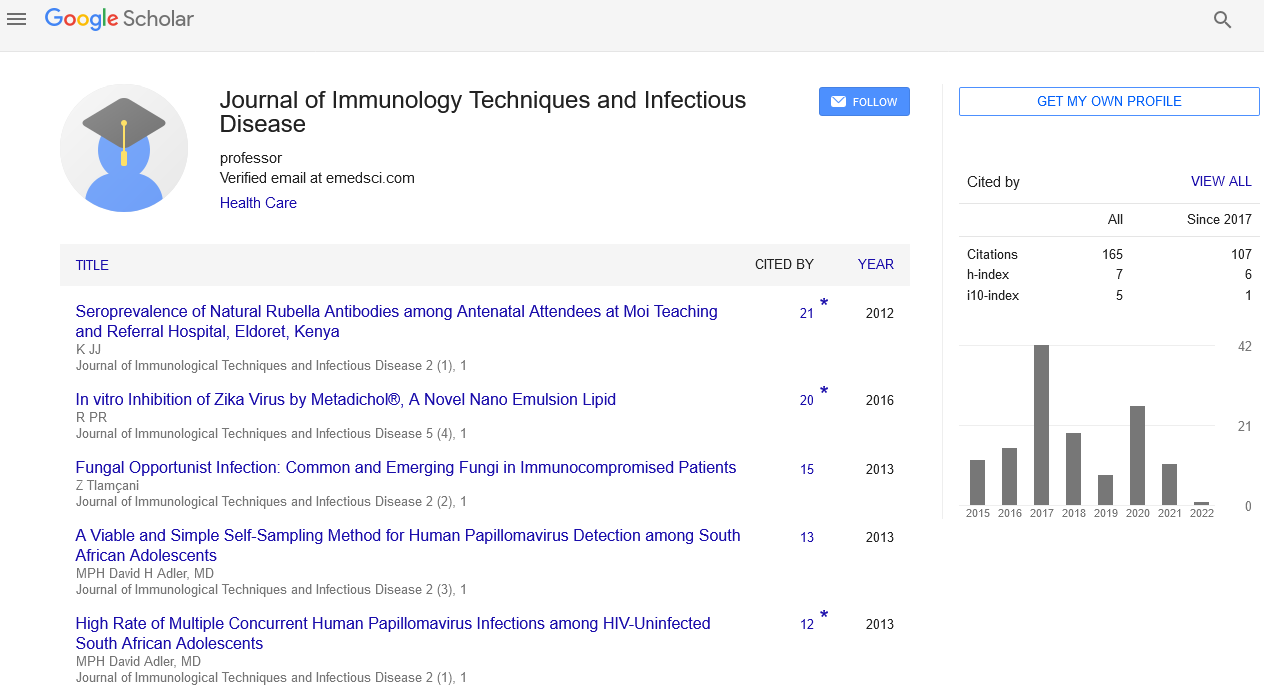Perspective, J Immunol Tech Infect Dis Vol: 13 Issue: 2
Examining the Infectious Disease Epidemiology: Transmission, Surveillance, and Challenges
Corash Benyam*
1Department of Medicine, University of California San Francisco, San Francisco, United States of America
*Corresponding Author: Corash Benyam,
Department of Medicine, University of
California San Francisco, San Francisco, United States of America
E-mail: benya.cor@gmail.com
Received date: 28 May, 2024, Manuscript No. JIDIT-24-144980;
Editor assigned date: 31 May, 2024, PreQC No. JIDIT-24-144980 (PQ);
Reviewed date: 14 June, 2024, QC No. JIDIT-24-144980;
Revised date: 21 June, 2024, Manuscript No. JIDIT-24-144980 (R);
Published date: 28 June, 2024, DOI: 10.4172/2329-9541.1000377.
Citation: Benyam C (2024) Examining the Infectious Disease Epidemiology: Transmission, Surveillance, and Challenges. J Immunol Tech Infect Dis 13:2.
Description
Epidemiology, the examination of illness transmission and control is essential for infectious disease management. This branch of medicine focuses on the incidence, distribution, and possible control of diseases and other factors relating to health.
Foundations of infectious disease epidemiology
Infectious disease epidemiology involves studying the interaction between the host, the pathogen, and the environment. It seeks to understand how infectious agents spread, how they cause disease, and how outbreaks can be prevented and managed.
Incidence and prevalence: Incidence refers to the number of new cases of a disease that occur in a specific period, while prevalence refers to the total number of cases existing at a particular time.
Transmission dynamics: Identifying the how diseases spread from one host to another host is fundamental. Transmission can be direct (person-to-person contact) or indirect (through vectors, contaminated objects, or the environment).
Epidemiological triangle agent: The microorganism that causes the disease, such as bacteria, viruses, fungi, or parasites.
Epidemiological triangle host: The person that transmits the illness is generally a human.
Epidemiological triangle environment: External factors that affect the agent and the opportunity for exposure, including climate, sanitation, and healthcare infrastructure.
Types of infectious disease outbreaks
Infectious disease outbreaks can vary widely in dimension, duration, and severity.
Endemic: A disease that is generally prevalent in a particular geographical region or demographic group. For example, malaria is prevalent over the majority of Africa.
Pandemic: An epidemic that has spread across many countries or regions and typically affects an enormous number of people. The COVID-19 pandemic, generated by SARS-CoV-2, represents a historical example.
Methods and tools in epidemiology
Epidemiologists use various methods and tools to study infectious diseases, including observational studies, laboratory investigation, and mathematical modeling.
Passive surveillance: Relies on healthcare providers to report cases of disease to health authorities. This method is essential for detecting outbreaks and monitoring disease trends.
Active surveillance: Involves proactive data collection by public health authorities, frequently during an outbreak investigation.
Descriptive studies: Characterize the distribution of diseases by time, place, and person. These studies provide essential data for identifying patterns and generating hypotheses.
Analytical studies: Establish cohort studies, case-control investigations, and randomized controlled trials. These studies are used to test hypotheses about the causes of diseases and the effectiveness of interventions.
Mathematical modeling: Models can predict the spread of infectious diseases and the potential impact of interventions. For instance, models have been essential in understanding the dynamics of COVID-19 and informing public health responses.
Importance of infectious diseases and their epidemiology
Several infectious diseases have significant impacts on public health globally. Understanding their epidemiology is essential for effective control and prevention.
Human Immunodeficiency Virus (HIV) Transmission: HIV is transmitted through contact with infected blood and from mother to child during childbirth or breastfeeding.
Epidemiology: Sub-Saharan Africa remains the most affected region, accounting for a significant proportion of global HIV cases. Antiretroviral Therapy (ART) results in to a significant decrease in mortality and morbidity.
TB Transmission: Tuberculosis (TB) is primarily spread through airborne particles when an infected person coughs or sneezes.
Epidemiology: TB remains a major global health issue, particularly in developing countries. The rise of Multidrug-Resistant TB (MDRTB) provides additional challenges.
Influenza transmission: Influenza spreads through respiratory droplets when an infected person coughs or sneezes.
Epidemiology: Seasonal influenza causes annual epidemics, and pandemic influenza can occur when new viral impacts develop. Vaccination is an essential preventive method.
COVID-19 Transmission: COVID-19 spreads primarily through respiratory droplets and contact with contaminated surfaces.
Epidemiology: The COVID-19 pandemic has caused significant global instability. Epidemiology aims to understand its long-term epidemiological patterns and inform public health techniques.
Challenges in infectious disease epidemiology
Epidemiologists face numerous challenges in studying and controlling infectious diseases.
Emerging and re-emerging infectious diseases: New pathogen, such as SARS-CoV-2, and re-emerging diseases, such as measles, provides continuing challenges. Global travel and ecological changes contribute to the emergence and spread of these diseases.
Antimicrobial Resistance (AMR): The rise of AMR complicates the treatment of infectious diseases. Surveillance and the development of new antibiotics and alternative treatments are critical to combating AMR.
 Spanish
Spanish  Chinese
Chinese  Russian
Russian  German
German  French
French  Japanese
Japanese  Portuguese
Portuguese  Hindi
Hindi 
